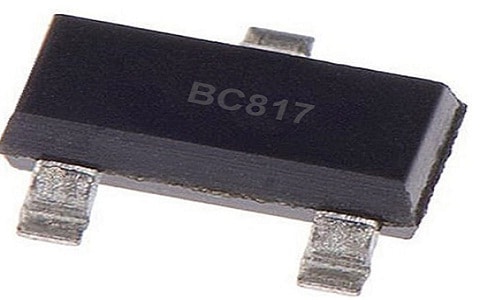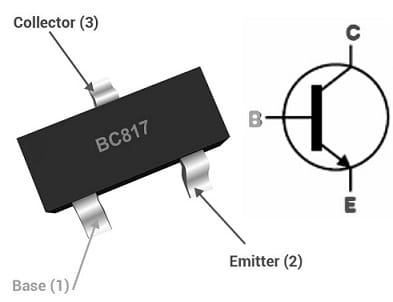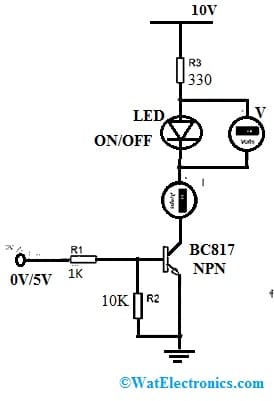An NPN transistor is a three-terminal semiconductor that amplifies weak signals to strong ones. In this transistor, the majority of charge carriers are electrons that move from the emitter region to the collector and it results in the formation of current. So this NPN transistor is sandwiched between two N-type material layers. Based on the construction, these are separated into two categories PNP and NPN. Transistors are made with silicon (or) germanium based on the application it is selected. This article provides information on a type of NPN transistor like; the BC817 Transistor, pin configuration, specifications, and its applications.
What is BC817 NPN Transistor?
BC817 is an NPN and SMD-type general semiconductor device used to amplify or switch power or signal. This is an NPN Transistor, thus we need to supply a small amount of +ve voltage to the transistor’s base terminal using a current limiting resistor known as a base resistor, so when the required amount of current is supplied throughout the base terminal then it will turn on. Thus, the highest collector current of this BC817 transistor is rated at 500mA with the highest EB voltage. The CE voltage of this transistor is 45V and the CB voltage is 5V. This transistor operates at 150oC.

BC817 Transistor
Working
When the BC817 transistor is biased, then it allows 500mA of maximum current with 0.46W maximum power across the CE junction, so this condition is known as the saturation state. In this state, a load consuming>500mA can damage the device. We know that a transistor is a current-controlled device thus whenever the base current is detached, the transistor will be completely turned off, this state is known as the Cut-off Region. So, the BE voltage could be approximately 500 mV.
Pin Configuration:
The pin configuration of the BC817 NPN Transistor is shown below. This transistor includes three terminals like a normal transistor which are discussed below.

BC817 Transistor Pin Configuration
- Pin-1 (Base): The base terminal helps to control the transistor biasing.
- Pin-2 (Emitter): This terminal emits electrons into the primary PN junction,
- Pin-3 (Collector): This terminal collects the electrons emitted from the emitter terminal.
Features & Specifications:
The features and specifications of BC817 NPN Transistor include the following.
- BC817 is an SMD Bipolar type Transistor.
- It is available in the SOT23 package.
- Its polarity is NPN.
- Its continuous collector current or IC is 500mAmps.
- Its emitter to base voltage or VBE is 5Volts.
- The maximum base current or Ib is 50mA.
- Maximum collector to base voltage or |Vcb| is 50 Volts.
- Its power dissipation is 0.46 W.
- The transition frequency or Tf is 100 MHz.
- Its noise figure is 2 dB.
- Its operating & storage junction temperature ranges from -65 to +175 °C
- Its collector capacitance is 5pF
- Maximum DC gain or hFE is 600.
- The material used for this transistor is Silicon.
- Collector to emitter maximum voltage or |Vce| is 45V.
- Its maximum collector current or |Ic max| is 0.5A
- The minimum forward current transfer ratio or hFE is 40.
Equivalent & Complementary Transistors
The equivalent BC817 transistors are; BC547, BC548, BC549, 2n3904, BC107, 2N2222, 2N3053, 2N2907, BC177B. Thus, the complementary BC817 transistor is BC807.
While looking for a suitable transistor for your application based on a few factors, it is very important to look into a few points on How to Select a Transistor.
BC817 Transistor Circuit
The transistor is a current-controlled device which means it can be switched ON/OFF by supplying the necessary base current. So a simple BC817 transistor circuit is shown below. The following circuit shows how BC817 transistor in the transistor behaves when current is applied to the base terminal and when there is no current at the base terminal.

BC817 Transistor Circuit
The transistor used in this circuit is a BC817 NPN transistor. Whenever no current is provided to its base terminal then the transistor will be left open, so the LED will be turned OFF. So, whenever we provide a base voltage using a current limiting resistor, then a small amount of current will supply through the base terminal & it will be turned on to make the LED ON.
Once we enable the BC817 transistor by providing a necessary current toward the base terminal it will stay on except the voltage supply at the base terminal reaches zero. So the base terminal cannot be left floating or else there could be false triggering toward the transistor which causes problems within the circuit. Thus, to resolve this problem, we need to connect a 10K pulldown resistor to pull down the transistor’s base terminal.
So connecting a base resistor to the base terminal of the transistor is mandatory to avoid it being damaged. Please refer to this link for; Choosing Base Resistance for Transistors in Electronic Circuits.
A transistor can also be interfaced with a microcontroller . Know how to interface a transistor to microcontroller.
Advantages & Disadvantages
The advantages of the BC817 transistor include the following.
- BC817 transistor is an NPN type general purpose transistor.
- It is a very versatile device.
- It has a high-frequency range and large bandwidth.
- It is available in a small SMD plastic package.
- It has a high collector current, low CE saturation voltage, and high current gain.
- This transistor testing is easy with a multimeter.
- These are inexpensive.
- They need a minimal voltage supply when providing higher voltage gain.It occupies less space due to its small size.
- It has a simple & durable design.
The disadvantages of the BC817 transistor include the following.
- Strong electrical currents cause transistors to heat up & break down.
- The current capacity within reverse blocking mode is low.
- It must be protected from high currents & voltages which can harm transistors.
- These are very sensitive to radiation & voltage stress.
- The power loss will be high when the frequency is high while switching.
Applications
The applications of the BC817 transistor include the following.
- It is used in different applications due to its versatility, large bandwidth, and high-frequency range which are discussed below.
- These are used in switching applications.
- BC817 Transistor is used in flashers, LED dimmers, etc.
- It is used in preamplifiers mainly for power amplifiers.
- Used in modulators & demodulators for RF frequency.
- It is used for switching & also medium power amplifier.
- In addition, this transistor is utilized to switch, control, or amplify a signal (or) power in high-frequency switching.
Replacing a suitable transistor in any circuit based on requirement is very important. To know how to replace it, please refer to this; Replacing Transistors in Electronic Circuits: Factors and Considerations.
Please refer to this link for the BC817 Transistor Datasheet.
Thus, this is an overview of the BC817 Transistor, pinout, specifications, circuit, working, advantages, disadvantages, and applications. So this is a semiconductor device, used in different switching & amplifier circuits. This is an NPN Transistor, so we need to supply a small amount of voltage to the base terminal using a current-limiting resistor. So the transistor will be turned on whenever the necessary amount of current supplies throughout the base terminal. Thus, to utilize this transistor as an amplifier, the gain value is required but this value can differ based on the manufacturer, it is highly suggested to check out the specific device datasheet before you perform the calculation. Here is a question for you, what is BC517 transistor?